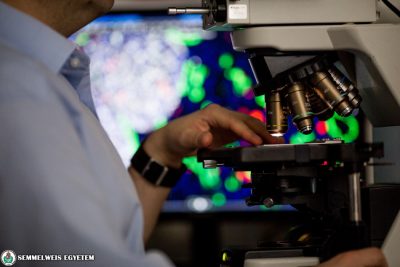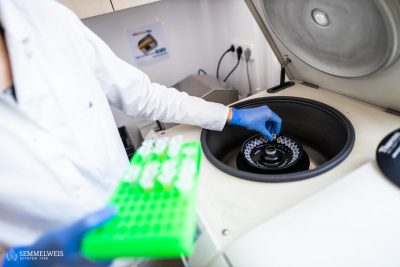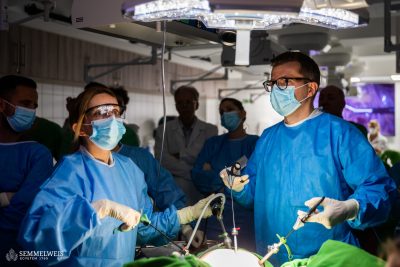 “The Biobank Network of Semmelweis University has been around for over 10 years. Last year, the National Research, Development and Innovation Office (NKFIH) published a call to apply for funding to connect to European research infrastructures,” explained Dr. Mária Judit Molnár, professor and head of the Institute of Genomic Medicine and Rare Disorders. According to her, the aim of the application was for the university network to join the Biobanking and Biomolecular Research Infrastructure – European Research Infrastructure Consortium (BBMRI – ERIC), one of the largest biobank networks and research infrastructures of Europe. To achieve this, a consortium called Hungarian BBMRI National Node was established, coordinated by Semmelweis University – besides the institution, the University of Szeged, the University of Pécs, the University of Debrecen, the South-Pest Hospital Center, and Richter Gedeon Plc. is also a member. Finally, in June this year, the Hungarian consortium joined the largest European biobank network as a full member within the framework of the organization’s virtual assembly of members.
“The Biobank Network of Semmelweis University has been around for over 10 years. Last year, the National Research, Development and Innovation Office (NKFIH) published a call to apply for funding to connect to European research infrastructures,” explained Dr. Mária Judit Molnár, professor and head of the Institute of Genomic Medicine and Rare Disorders. According to her, the aim of the application was for the university network to join the Biobanking and Biomolecular Research Infrastructure – European Research Infrastructure Consortium (BBMRI – ERIC), one of the largest biobank networks and research infrastructures of Europe. To achieve this, a consortium called Hungarian BBMRI National Node was established, coordinated by Semmelweis University – besides the institution, the University of Szeged, the University of Pécs, the University of Debrecen, the South-Pest Hospital Center, and Richter Gedeon Plc. is also a member. Finally, in June this year, the Hungarian consortium joined the largest European biobank network as a full member within the framework of the organization’s virtual assembly of members.
With Hungary, BBMRI-ERIC now has 22 members and is in contact with nearly 30 industry partners and patient organizations. The organization performs outstandingly well in various grant applications and research programs: the success rate of its applications under Horizont 2020, the program defining the European Union’s research, development, and innovation policy for the period 2014-2020, was 36%, compared to the EU’s average of 7%, pointed out Dr. Mária Judit Molnár. She added that with the accession, the Hungarian consortium aims to participate equally well in research applications and international collaborations, as well as to reduce the time spent on publication and projects, and to bring joint work with academic and industrial partners even more to the fore. “It is important to collect samples stored in biobanks according to the same principles and the same quality assurance, preferably using a common data interface – in the past, they were fragmented, everyone used different systems,” the director pointed out, emphasizing that in addition to making the data and samples of Hungarian biobanks available to the experts of other participants of the organization, Hungarian researchers will also have access to the complete database and samples of BBMRI-ERIC. For example, if someone would like to develop a medicine for juvenile Parkinson’s patients, the European search engine will make it easy to find which institution in which country has a sample that could help with the research.
“However, the security of the individuals and their personal data must not be forgotten – genomic data is so special and unique that it can be traced back to people, which is why it must be shared in a way that it does not happen,” she said. By joining BBMRI-ERIC, even better, more effective therapies and treatments will be available to patients through higher quality samples and data storage, as well as research grants. Along with the cooperation, Semmelweis University also has the opportunity to transform its own Biobank Network management in accordance with the new requirements, added Dr. Mária Judit Molnár.
Biobanks are collections that store samples from living organisms for research and medical purposes. The Semmelweis University Biobank Network was launched in 2012 after a Senate resolution establishing it in 2009. It currently operates in 14 biobanks in 13 departments, where nearly 100,000 samples are stored in a quality-assured manner – including all types of medical samples, from blood and tissues to DNA and RNA to a variety of surgical materials. Biological samples are used for clinical genetic diagnostics, pharmacogenomic studies, basic morphological, genomic, proteomic, and metabolomic research on disease pathogenesis, biomarker identification, and genetic epidemiological studies.
Ádám Szabó
Translation: Viktória Kiss
Photo: Attila Kovács – Semmelweis University



